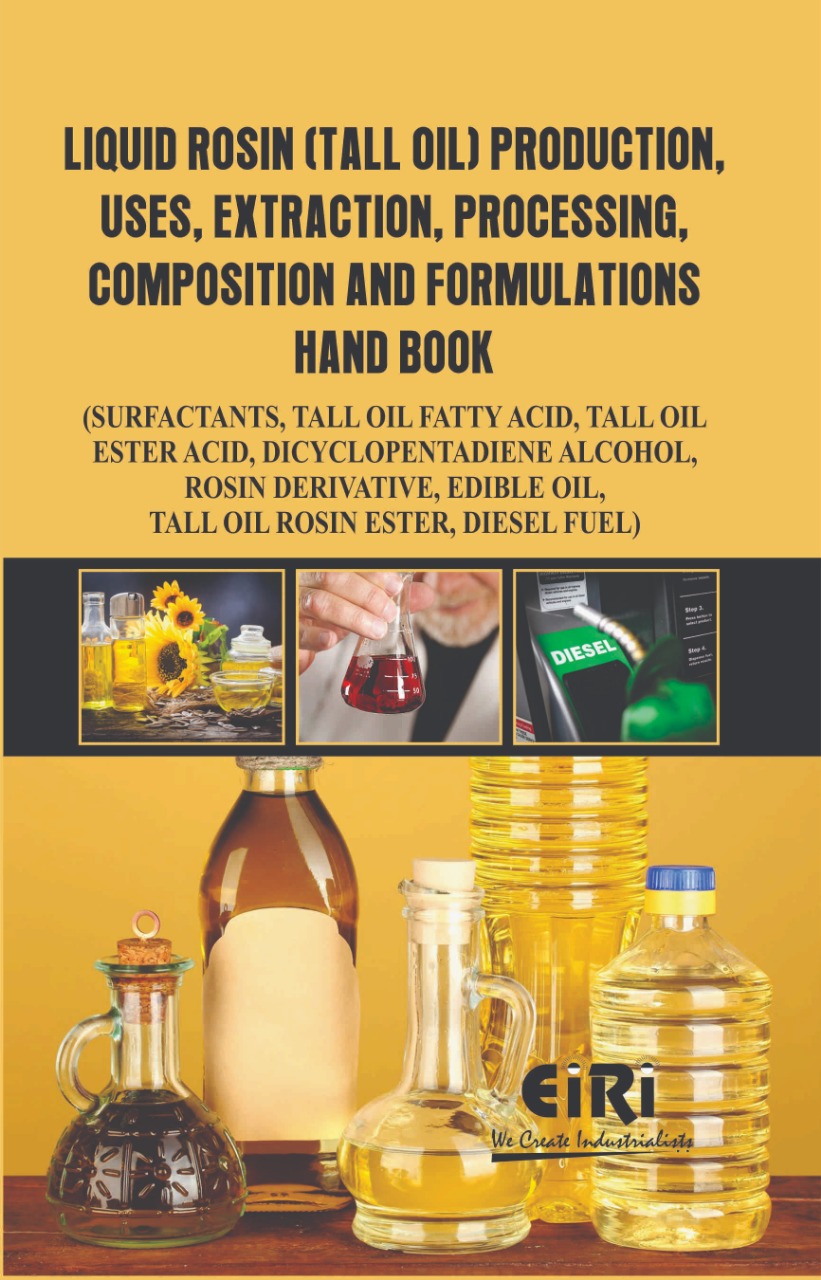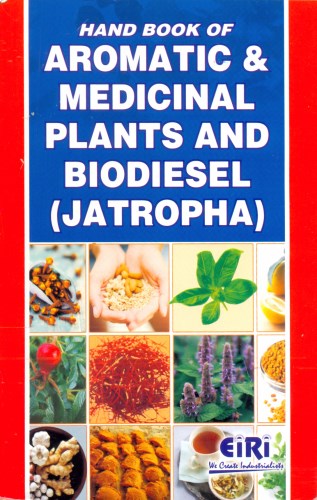Description
Contents
1. Tall Oil (Liquid Rosin) Production and Processing
- Introduction
- Composition
- Fatty acids
- Resin acids
- Unsaponifiables
- Uses of Liquid Rosins
- Tall oil
- Lignins
- Calcium ions
- Sulphide ions
- Factors affecting quality of CTO
- Dehydration
- Depitching
- Rosin separation
- Heads separation
- Fatty acid separation
2. Composition of Distilled Tall Oils (DTO)
- Experimental Procedures
- Results and Discussion
3. Surfactants From Tall Oil Rosin
- Cationic Surfactants Experimental
- Preparation of maleopimaric acid (MPA)
- Preparation of rosin cationic surfactants (QRMAE)
- Electrochemical measurement
- Surface Activity of the prepared surfactants
- Esterification of rosin
- Esterification of RMA-MPEG 750
- Characterization of the prepared Surfactants
- Surface Activity of the prepared surfactants
4. Crude Tall Oil for Wood Protection
- Sources, production and utilization of crude tall oil
- Tall oil as a wood protection agent
- Wood extractives and natural durability
- Effect of tall oil on the biological durability of wood
- Effect of tall oil on water repellency
- Reducing the amount of oil needed
- Enhancing the drying properties of crude tall oil
- Enhancing the wood protection properties of tall oil
- Biodegradability of tall oil-based wood preservatives
5. Synthesis and characterization of tall oil fatty acid
- Resin synthesis
- Materials
- Curing process
- Trial experiments for scheme 2 and scheme 3
- Characterization of resins
- Results and discussion of resins
- FTIR analysis of the synthesized thermoset resins
- Composite preparation
- Hand lay-up impregnation
- Characterization of composites
- Flexural testing
- Dynamic mechanical thermal analysis
6. Tall Oil Fatty Acid (Alkyd-resin, Alkyd Acrylic
- Copolymers, Drying Processese
- Introduction
- Alkyd resin
- Alkyd-acrylic copolymers
- The drying process
- Synthesis of copolymers
- Celluloses used as fillers
- Films and coatings
- Characterization
- Surface modification
- Degree of substitution
- Barrier properties
7. Phytosterols, Phytostanols and Their Esters From Tall Oil (Liquid Rosin)
- Manufacturing
- Production of sterols from vegetable oil distillates
- Production of sterols from wood pulp/tall oil
- Production of phytostanols from phytosterols
- Production of phytosterol and phytostanol esters
- Free fatty acid route
- Methylester route
- Commercial suppliers
- Chemical Characterization
- Composition and properties
- Quality of phytosterols, phytostanols and their esters
- Analytical methods
- Regulatory status
- Reactions and fate in foods
- Stability at high temperatures
8. Distilled Tall Oil (DTO)
- The BUS model
9. Antiproliferative evaluation of tall-oil docosanol and tetracosanol
- Materials and Methods
- Raw materials
- Formulation of long-chain alcohols in Pluronic® F-68
- Cell culture assays
- Statistical analysis
10. Synthesis and Characterization of Novel
- Polyurethanes Based on Tall Oil
- Synthesis of polyols
- Preparation and characterization of polyurethanes
- Properties of polyols
- Structure of polyols and polyurethanes
- Properties of polyurethanes
11. Production of Tall Oil Fatty Acid
12. Tall Oil (Liquid Rosins) Ester-acid Composition For Coating
13. Dicyclopentadiene Alcohol Rosin Derivatives
14. Manufacturing edible oils from tall oil fatty acids
15. Skin care product containing tall oil fatty acids and vegetable oils with manufacturing formula
16. Process For Manufacturing Valuable Products From Tall Oil Pitch
17. Chemically modified, maleated unsaturated fatty acids and the salts
- Ricinoleic Acid Modification
- Polyamine Modification
- Amino Alcohol Modification
- Imidazoline Modification
- Metal Chelate Modification
- Ester Modification
- Amino Acid Modification
- Polyfunctional Corrosion Inhibitors
- Sulfonate & Sulfate Modification
- General Considerations
- Maleation of Crude Tall Oil
18. Manufacture of A Tall Oil Rosin Ester
- Detailed Description
- Odor Level Comparison Tests
19. Production of Diesel Fuel From Crude Tall Oil
- The Drawings
- Description
20. High Temperature Corrosion Inhibition
- Performance of Imidazoline and Amide
- Experimental
- Inhibitor Performance Evaluation
- The tests are conducted as follows
21. Hydraulic oil Based on Natural Fatty Acid Esters
List of Tables
- Table 2.1 Gross Compositional Characteristics of American Distilled Tall Oilsa
- Table 2.2 Composition of Fatty and Resin Acids in American Distilled Tall Oils
- Table 2.3 GLC Retention and NMR Characteristics of the Methyl Secodehydroabietatesa
- Table 2.4 Composition of Pimaric-and Isopimaric-Type Acids Comprising Resin Acids of American Distilled Tall Oilsa
- Table 4. 1. Composition of CTO
- Table 4.2. Degree of water repellent efficiency (DEt) of tall oil-treated pine sapwood samples measured after 1 and 96 hours of water immersion
- Table 4.3. Properties of the tall oil emulsions
- Table 5.1: Different mass ratio of MA to HOTOFA
- Table 5.2: DSC analysis table of all uncured resin samples
- Table 5.3: TGA analysis for different cured resins
- Table 5.4: Summary of the DMTA result
- Table 5.5: Summary of charpy properties
- Table 6.1. Fatty acid composition of various oils used in coatings
- Table 6.2. Alkyd resins studied and used in copolymer synthesis
- Table 6.3. Generalized recipe for copolymerizations
- Table 6.4. Synthesized and studied copolymers
- Table 6.5. Synthesized copolymer dispersions, which
- were applied on paperboard
- Table 6.6 Relative proportions of each proton and proton group in the polyol region
- Table 6.7. Tg values of copolymer films and onset temperatures of the DMA measurements.The results are averages of five measurements
- Table 6.8. Comparison of the quantity of fatty acids attached based on the integrated cellulose and acyl peaks in the 13C CPMAS NMR spectra
- Table 6.9. Degree of substitution and O/C ratio calculated from XPS measurements
- Table 6.10. Mechanical properties of copolymer films studied with DMA, the results are averages from 3 to 8 measurements
- Table 7.1. Commercial suppliers of phytosterols, phytostanols and/or their esters; 1) TO: tall oil; VO: vegetable oil
- Table 7.2: Physical characteristics and composition of different commercial phytosterols, phytostanols and their esters; 1) from TO sterols; 2) from VO sterols; 3) mainly sitosterol and campesterol
- Table 7.3. Phytostanol concentrations in food products on the market, including portion sizes
- Table 8.1: Composition of test materials
- Table 8.2: Calculation of the MTT, PGE2, and (MTT + PGE2) combined score values
- Table 8.3: Results from the MTT assay and the PGE2 determination for tissue treated with a single application of tall oils
- Figure 8.1: Determination of the cytotoxicity of single and repeated applications of tall oils
- Table 8.4: Results from the MTT assay and the PGE2 determination for tissue treated with repeated applications of tall oils
- Table 9.1. Percentage of viability of CHO and melanoma cell cultures in the presence of long-chain aliphatic alcohols
- Table 10.1. Specifications of oils
- Table 10.2. Characteristics of polyols
- Table 10.3. Thermal stability of polyurethanes
List of Figures
- Figure 1 .1 The tall oil process
- Figure 3.1. FTIR spectra of a) RMAE and b) QRMAE
- Figure 3.2. 1HNMR spectra of a) RMAE and b) QRMAE
- Figure 3.3 Relation between surface tension of QRMAE and time at different concentrations in a) water and b) 1M aqueous HCl solutions at 25°C.
- Figure 3.4. Adsorption isotherms of QRMAE at different concentrations in a) water and b) 1M aqueous HCl solutions at 25°C.
- Figure 3.5. FTIR Spectra of a) RMA and b) RMA-(MPEG 750)3
- Figure 3.6. Relation between surface tension of R-MPEG 750 and time different concentrations in 1M aqueous HCl solutions.
- Fig. 4.1. Simplified diagram of the tall oil distillation pr
- Fig. 4.2. Fatty acids.
- Fig. 4.3. Resin acids.
- Fig. 4.4 Degree of efficiency after the initial wetting and drying cycle, measured after 1 hour of water immersion
- Fig. 4.5 Degree of efficiency after the initial wetting and drying cycle, measured after 96 hours of water immersion
- Fig. 4.6. Degree of efficiency after six wetting and drying cycles, measured after 1 hour of water immersion
- Fig. 4.7. Degree of efficiency after six wetting and drying cycles, measured after 96 hours of water immersion
- Fig. 4.8. DSC diagrams (110°C air flow) indicating the oil oxidation rate
- Fig. 4.9. Water uptake by tall oil-treated pine sapwood in the seventh wetting and drying cycle
- Fig. 4.10. Amounts of oil pressed out of the samples during the compression test
- Fig. 4.11. Typical particle size distribution of a tall oil-based emulsion
- Figure 5.1: synthesis scheme 1
- Figure 5.2: synthesis scheme 2
- Figure 5.3: synthesis scheme 3
- Figure 5.4: Experimental set-up for synthesis of thermosetting resin
- Figure 5.5: the obtained resins with three different mass ratio of MA to HOTOFA
- Figure 5.6 : FTIR spectra comparison of TOFA and HOTOFA resins
- Figure 5.7: FTIR spectra comparison of HOTOFA, MHOTOFA 1:1, MHOTOFA 1.5: 1 and MHOTOFA 1.76:1resins
- Figure 5.8: DSC curve of uncured MHOTOFA 1to1 (no styrene) resin
- Figure 5.9: DSC curve for cured MHOTOFA 1to1 resin (no styrene, room T for 1h and post cure in 150°C for another 1h)
- Figure 5.10: Comparison of the DSC scan for cured and uncured MHOTOFA 1to1 (no styrene) resin
- Figure 5.11: TGA analysis of cured MHOTOFA 1:1 resin (no styrene)
- Figure 5.12: Viscose fiber and fiber mats lay-up orientation
- Figure 5.13: Six different composites from 3 different resins (with or without styrene) reinforced by viscose fiber
- Figure 5.14: Test specimens for flexural, DMTA, charpy, tensile
- Figure 5.15: Flexural strength comparison of the composites
- Figure 5.16: Flexural modulus comparison of the composites
- Figure 5.17: Strain at break% comparison of the composites
- Figure 5.18: variation in the storage modulus of the MHOTOFA composites
- Figure 5.19: Tan delta curves of the MHOTOFA composites
- Figure 5.20: the loss modulus curves of MHOTOFA composites
- Figure 5.21: Comparison of the storage modulus between the reinforced resin (composite) and the unreinforced resin, both blended with styrene
- Figure 5.22: Impact strength of the composites
- Figure 6.1. Structure of typical alkyd resin
- Figure 6.2. Miniemulsion and conventional emulsion polymerization
- Figure 6.3. Schematic presentation of the oxidative drying of alkyd resin
- Figure 6.5. SEC chromatograms of alkyd resins
- Figure 6.6. Monomer conversion of copolymers with different wt% of conjugated alkyd resin (BA-MMA ratio is 80:20) (copolymers11-15 in Table 6.4)
- Figure 6.7. Monomer conversion of copolymers with different wt% of nonconjugated Alkyd-TMP-3 and BA as monomer (copolymers 1-5 in Table 6.4)
- Figure 6.8. Particle-size distribution of emulsion and dispersion with various alkyd contents (copolymers 1, 3, 5 in Table 6.4)
- Figure 6.9. Grafting of acrylic macroradical to double bond (a-c) and bis-allylic site (d-f) in the fatty acid chain. a) Macroradical attacks DB in fatty acid chain. b) Grafting occurs and a new radical is formed. c) Polymerization continues at the new radical site. d) Macroradical attacks allylic hydrogen in fatty acid chain. e) Hydrogen is abstracted and a new radical is formed in fatty acid chain, where new radical approaches. f) Macroradical grafts to radical site in fatty acid chain
- Figure 6.10. Monomer conversion and acrylic degree of grafting. BA-MMA ratio (wt%) was 80:20 in samples with conjugated alkyd (copolymers 11-15 in Table 6.4) and 100:0 in samples with nonconjugated alkyd (copolymers 1-5 in Table 6.4
- Figure 6.11. a) Effect ofBA concentration on grafting site and efficiency. b) Effect of alkyd-acrylate ratio on various grafting sites (copolymers 16-20 in Table 6.4)
- Figure 6.12. DSC thermograms of alkyd resin and copolymers (copolymers 16-20 in Table 6.4)
- Figure 6.13. a) TG and b) DTG curves showing thermal stability of alkyd resin, alkyd-acrylic copolymers, and acrylic copolymer.
- Figure 6.14. Two parts of FTIR spectra of neat whiskers and fatty acid-modified whiskers.The carbonyl peak at app. 1740 cm-1 is marked with dotted line
- Figure 6.15. Thermal stability of neat whiskers and fatty acid-modified whiskers presented as TGA curves
- Figure 6.16. a) ssNMR spectrum of copolymer film and freeze-dried copolymer. b) FTIR spectra of copolymer film after various drying times showing the decreasing intensity of the cis H-C=CH peak (marked with dotted line)
- Figure 6.17. Stress-strain curves of copolymer films with various alkyd contents. One measurement of each film sample set is presented
- Figure 6.18. Storage modulus of copolymer films with various alkyd contents. One measurement of each film sample set is presented
- Figure 6.19. Figure 1 Water and oil absorbance of copolymer-coated cupboards (copolymers 30-37). Samples 34-37 were crosslinked with GMA
- Figure 6.20. Effect of TOFA-modified whiskers on mechanical properties of films
- Figure 6.21. Effect of various cellulose types on mechanical properties of the films
- Figure 6.22. Effect of TOFA-modified cellulose on a) oxygen barrier properties (copolymers 32 and 33) and b) water and oil absorbance (copolymer 32) of copolymer-coated paperboards.
- Figure 7.1. Steroid skeleton
- Figure 7.2. Molecular structure of some phytosterols, phytostanols and a fatty acid ester
- Figure 8.2: Determination of the irritancy potential of single and repeated applications of tall oils
- Figure 8.3: The combined cytotoxicity and irritancy potential of single and repeated applications of tall oils
- Fig. 9.1. Structure of long-chain aliphatic alcohol (polycosanols): docosanol and tetracosanol
- Fig. 9.2. Effect of long-chain aliphatic alcohol type on CHO-K1 cell growth
- Fig. 9.3. Effect of long-chain aliphatic alcohol type on melanoma cell growth
- Fig. 10.1. Chemical structure of the synthesized polyols and polyurethanes, where R1 – residue of saturated and unsaturated fatty acids (C16-C24) and R2 – residue of aromatic diisocyanate
- Fig. 10.2. IR-spectra of polyols (1, 2) and urethanes (3, 4), based on tall oil FOR2 esters (1, 3) and diethanolamides (2, 4)
- Fig. 10.3. IR-spectra of tall oil diethanolamides (1, 2) and esters (3, 4), containing 2 % (1, 3) and 20 % (2, 4) of rosin acids
- Fig. 10.4. IR-spectra of polyurethanes based on tall oil diethanolamides (1, 2) and esters (3, 4), containing 2 % (1, 3) and 20 % (2, 4) of rosin acids
- Fig. 10.5. Density of polyurethanes versus the content of rosin acids
- Fig. 10.6. Tg of polyurethanes versus the content of rosin acids
- Fig. 10.7. Modulus of elasticity of polyurethanes versus the content of rosin acids
- Fig. 10.8. Tensile strength of polyurethanes versus the content of rosin acids
- Fig. 10.9. Elongation at break of polyurethanes versus the content of rosin acids
- Fig. 10.10. Shear bond strength to wood (W) and aluminium (Al) for polyurethanes versus the content of rosin acids
- Fig. 10.11. TGA curves of polyurethanes with the content of rosin acids of 2 %
- Fig. 19.1 is a general flow scheme of one embodiment of the invention
- Fig. 19.2 is a more detailed flow scheme of one embodiment of the invention






